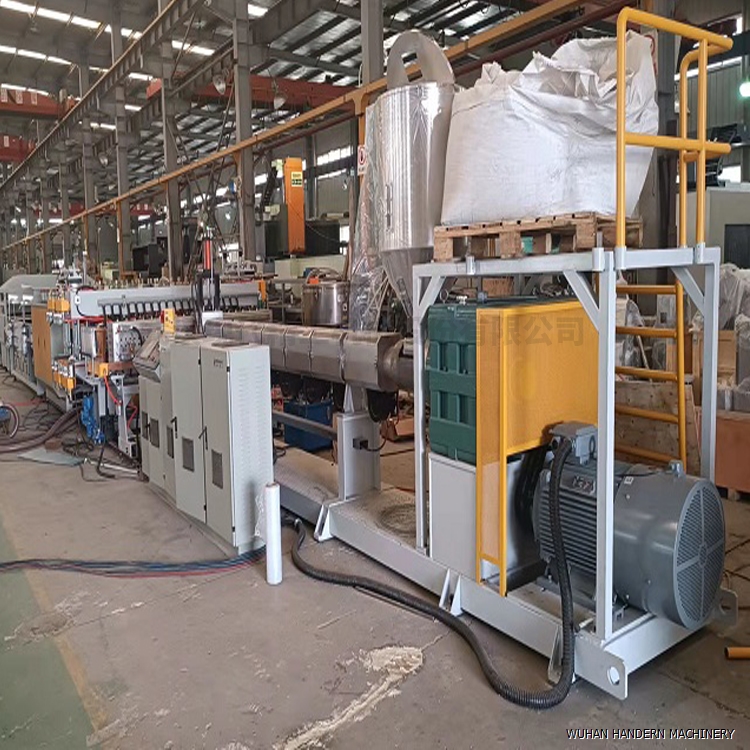What is the ABA co extrusion principle of the hollow board production line
DATE:2023/6/25 14:27:23 / READ: / SOURCE:This station
The hollow plate production line is a type of equipment for producing various hollow plates, and the ABA double-layer plate extrusion technology is one of its important working principles. This article will introduce the working principle of ABA double-layer sheet extrusion in the hollow board production line.
 Firstly, we need to understand the structure of ABA double-layer panels. The ABA double-layer board is composed of two layers, A and B. The A and B layers can be made of different polymeric materials according to usage needs. This structure enables ABA double-layer panels to have good physical and mechanical properties and chemical stability, while also reducing their production costs.
Firstly, we need to understand the structure of ABA double-layer panels. The ABA double-layer board is composed of two layers, A and B. The A and B layers can be made of different polymeric materials according to usage needs. This structure enables ABA double-layer panels to have good physical and mechanical properties and chemical stability, while also reducing their production costs.
The ABA double-layer board extrusion process in the hollow board production line adopts the technology of extrusion plastic processing. This technology involves heating plastic materials to a molten state and then extruding them into the desired shape of the mold through an extrusion machine. In the extrusion process of ABA double-layer sheet, plastic particles from layer A and layer B are added to different extruders, and then heated and mixed. The two layers of plastic are continuously extruded through the extrusion head to form ABA double-layer sheet.
In the extrusion process of ABA double-layer sheet, controlling temperature and extrusion pressure is crucial. Excessive or insufficient temperature and extrusion pressure can affect the quality and production efficiency of ABA double-layer panels. To ensure the stability and consistency of the process, hollow plate production lines are usually equipped with multiple heating zones and pressure sensors to ensure the repeatability of each step in the extrusion process.
In addition, the hollow board production line also adopts advanced control systems to achieve automated production. For example, technologies such as PLC (Programmable logic controller) and HMI (Human Machine Interface) can realize the monitoring, control and data recording of the production process. This not only improves production efficiency and accuracy, but also reduces errors and losses caused by manual intervention.
 In summary, the ABA double-layer sheet extrusion process of the hollow board production line is an efficient, stable, and reliable production method. It can not only meet the diversified demand for hollow panels in the market, but also promote the improvement of production efficiency and product quality. We believe that with the continuous progress of technology and the expansion of applications, the ABA double-layer plate extrusion process of the hollow plate production line will play a more important role in the future.
In summary, the ABA double-layer sheet extrusion process of the hollow board production line is an efficient, stable, and reliable production method. It can not only meet the diversified demand for hollow panels in the market, but also promote the improvement of production efficiency and product quality. We believe that with the continuous progress of technology and the expansion of applications, the ABA double-layer plate extrusion process of the hollow plate production line will play a more important role in the future.

The ABA double-layer board extrusion process in the hollow board production line adopts the technology of extrusion plastic processing. This technology involves heating plastic materials to a molten state and then extruding them into the desired shape of the mold through an extrusion machine. In the extrusion process of ABA double-layer sheet, plastic particles from layer A and layer B are added to different extruders, and then heated and mixed. The two layers of plastic are continuously extruded through the extrusion head to form ABA double-layer sheet.
In the extrusion process of ABA double-layer sheet, controlling temperature and extrusion pressure is crucial. Excessive or insufficient temperature and extrusion pressure can affect the quality and production efficiency of ABA double-layer panels. To ensure the stability and consistency of the process, hollow plate production lines are usually equipped with multiple heating zones and pressure sensors to ensure the repeatability of each step in the extrusion process.
In addition, the hollow board production line also adopts advanced control systems to achieve automated production. For example, technologies such as PLC (Programmable logic controller) and HMI (Human Machine Interface) can realize the monitoring, control and data recording of the production process. This not only improves production efficiency and accuracy, but also reduces errors and losses caused by manual intervention.

Author:admin




